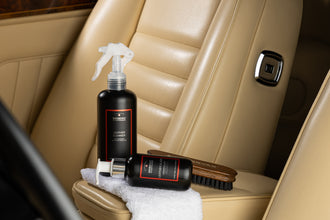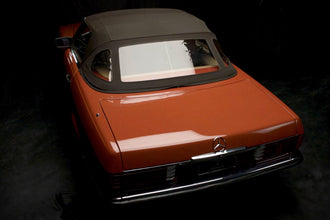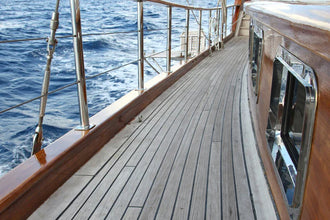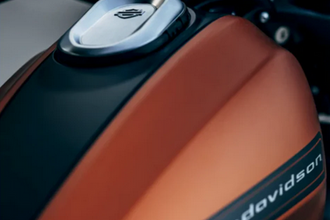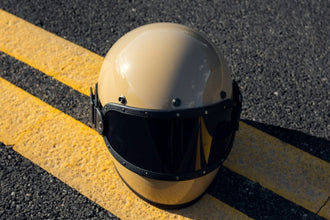Frequently Asked Questions
-
About Carnauba Wax
The art of composition
The use of carnauba waxes for glossy surfaces has a long tradition dating back to the 19th century. The disadvantage of these waxes was their low durability, as 100% pure carnauba wax can be easily wiped away. The SWISSVAX secret of exceptionally durable carnauba formulations lies in the mixture of carnauba wax with other waxes, fruit oils, and the multi-hour manufacturing process in true manufactory work. Learn more about carnauba wax.
Handcrafted tin by tin
Even today, the carnauba waxes are produced exclusively by hand in our manufactory and filled tin by tin. The high-quality and complex formulations are not suitable for industrial production.
Our waxes, made with natural raw materials, leave no white residues on rubbers or body edges.
A 200 ml tin is sufficient for up to 15 applications.
For the perfect waxing result, the paint must be pretreated with our Cleaner Fluid Regular. -
Purchase products / On-site consultation in Fällanden
Flagship Store and Car Detailing Center Fällanden
We are pleased to welcome you at Tämperlistrasse 3, 8117 Fällanden for advice and product purchases in our flagship store at the headquarters.
A free quote for the detailing of your vehicle can also be provided by our experts without an appointment.Factory Store & Service Center for Vehicle Detailing
Swissvax AG
Tämperlistrasse 3
8117 Fällanden
Phone: +41 840 851 851
E-mail: customerservice@swissvax.comOpening hours
Mon – Fri: 08:00 – 12:00 / 13:00 – 17:30 -
"Which wax can I use for polishing..?" The difference between wax and polish
- In common parlance, the term “car wax” is actually meant to be “car polish.” Car polishes are mostly liquid, contain water, solvents, abrasives and smaller portions of waxes and polymers. These products are applied and polished off after drying. By hand or with a polishing machine. Pure, real waxes, in contrast to car polishes, are completely free of abrasives.
- SWISSVAX paint care is carried out in 3 steps: WASH (with 'Car Bath' or 'Lavish Shampoo') / CLEAN PAINT (with 'Paint Rubber' and 'Cleaner Fluid') / SEAL PAINT (with SWISSVAX Carnauba Wax)
Polish
Our Swissvax car polishes "Cleaner Fluids" are not only effective means against paint scratches, but also create a perfectly smooth paint base. Depending on the type of scratch removal – manual or with the help of a polishing machine – you can choose different intensities of polish and thus create a new paint finish. Holograms can be removed as well as clouds. Swissvax Cleaner Fluid polishes for hand polishing or for professional polishing with the machine. Easy application of the polishes and rubbing in with pressure, whereby the mixed-in micro granulates grind each other off and the polish thus becomes finer and finer. Due to the own formula of the Swissvax car polishes and polishing agents, overly aggressive polishing is avoided.Wax
Carnauba waxes not only make your paint shine. For deep reflective surfaces and a completely new definition of "gloss." The paint surface receives a long-lasting natural wax sealant. To this day our car waxes are produced exclusively by hand in our manufactory and filled tin by tin. -
Does a second layer of wax make sense?
Yes.
A second layer of wax increases the protective layer of the sealant. This has two advantages: the refraction of the light falling on the paint surface is further enhanced and the protective layer gains longer durability. Between the first and second layer of wax you should wait 3 hours to allow the wax to bond perfectly with the paintwork.
-
How much does vehicle detailing cost?
As individual as your vehicle, the preparation can also be individual due to various factors/parameters.
Therefore, we take the time, even for a spontaneous visit, at our Car Detailing Center at Tämperlistrasse 3, 8117 Fällanden. We will be happy to advise you and prepare a free quotation.
Factory Store & Service Center for Vehicle Preparation:
Swissvax AG
Tämperlistrasse 3
8117 Fällanden
+41 840 851 851
customerservice@swissvax.comOpening hours
Mon – Fri:
08:00 – 12:00
13:00 – 17:30 -
Should I apply Lotos Speed after waxing?
Yes.
Lotos Speed can additionally be applied on top of the wax sealant. This has the advantage that the protective layer becomes even more water-repellent and gains longer durability.
After applying Lotos Speed you should wait 3 hours so that the wax can first bond perfectly with the paintwork.
-
Why can’t I use Cleaner Fluid (hand polish) as a machine polish?
SWISSVAX hand polishes (Cleaner Fluid) and machine polishes (Cleaner Fluid PROFESSIONAL) differ, among other things, in their viscosity. Hand polishes are more liquid, machine polishes are thicker.
Cleaner Fluid Regular is not suitable for machine polishing. The product is too liquid and would cause too much splatter. Anyone wishing to work with a polishing machine should use Cleaner Fluid Professional Regular.
-
"Cut Performance" of Cleaner Fluid Professionals (machine polish)
On a scale from 0 to 100:
0 = zero cut
100 = full cut
Professional Regular 22 -> 1-stage polishing possible
Professional Medium 30 -> 1-stage polishing possible
Professional Strong 51 -> 2-stage polishing necessary,since the cut begins at 55 and therefore cannot reach the finish cut*
*The longer you work with the polish and the start cut, the finer and deeper the cut will be afterwards. The Professional version of Regular (instead of the hand polish) is a completely different product for machine polishers:It is a nano polish and the softest of the 3 Professional polishes (Regular, Medium, Strong
-
What is PTFE?
PTFE resin (polytetrafluoroethylene) belongs to the family of paraffinic polymers in which hydrogen has been partially or completely replaced by fluorides.
The original PTFE resin was invented by DuPont in 1938 and christened Teflon. PTFE has extraordinary resistance to chemicals as well as one of the lowest coefficients of friction of all materials known to us today.
-
Opaque: for matte paints and matte films.
No conventional polishes, waxes, insect removers or insect sponges may be used on matte paints. In order for matte paints to retain their matte appearance (and not be polished to gloss), special products are required which Swissvax has developed under the name “Opaque” exclusively for matte paints as well as matte paint films.
The premium wax from the Opaque line, with its 40 vol.% of pure Brazilian Grade One carnauba wax, provides impressive protection against fingerprints, dirt, water spots and insect residues. The matte appearance of the matte finish is fully preserved. Due to its extremely easy application, the Opaque wax is extremely popular with both private and professional users.
For the perfect wax result, the paint must imperatively be pretreated with our Pre-Cleaner Opaque.
-
Can I polish matte paint?
Matte surfaces cannot be polished, as they would otherwise become glossy.
Therefore, there is no polish for matte paints. Before sealing, however, the paint must still be cleaned, including preparation for accepting the wax: with Swissvax Pre-Cleaner Opaque.
-
How do I seal matte-finished rims?
For a vehicle with a matte finish, the following procedure and products are recommended:
- Wash and dry the vehicle
- Spray an area with Pre-Cleaner Opaque and wipe off within 10–15 sec, move on to the next area
- Apply Opaque Wax to a small area, wait briefly (about 15 sec and then buff off), move on to the next area
For matte rims the following procedure and products are recommended:
- Wash and dry the rims
- Spray an area with Pre-Cleaner Opaque and wipe off within 10–15 sec, move on to the next area
- Apply Autobahn Wax to a small area, wait briefly (about 15 sec and then buff off), move on to the next area
-
Wax or ceramic coating? Advantages and disadvantages
A ceramic coating has one enormous advantage: increased hydrophobicity (beading of liquids).
A carnauba wax does not achieve this strong hydrophobicity, but it is clearly superior in gloss level and application.
Along with the advantages of long durability and beading behavior of ceramic coatings, there are also some disadvantages:- Paint surface permanently coated with an additional layer
- Long-lasting, but with a slowly decreasing care level
- Complex application with risks involved
- Not scratch-proof, but more resistant than waxes
- Scratches cannot simply be polished out
- In the case of a repaint, the coating must be reapplied, which creates a difference (even in color) compared to the already existing ceramic coating
The advantages of a SWISSVAX carnauba wax:
- Various gloss levels possible depending on the volume of carnauba content
- Easy application, always successful, even without prior knowledge
- Wax can always be reapplied, even on repainted areas with the highest wear (strongest mechanical stress from the road)
- Constant level that can be maintained at the same standard, since re-treatment of stressed areas is possible
In other words, ceramic and wax coatings are two different worlds.
If you choose a ceramic coating, the last layer should also be ceramic so that hydrophobicity and hardness are ensured.
If you choose our carnauba waxes, the top layer should also be carnauba, otherwise the proverbial “lollipop shine” (wet look) and resistance to water drops (rain) are lost.Wax on ceramic: possible, but on ceramic the wax will last only shorter, about 2 months maximum.
Ceramic on wax: “works,” since the aggressive chemistry of the ceramic dissolves the wax.Our recommendation: Carnauba wax with our water-based KERAMIQ9 for the combination of maximum gloss level and high hydrophobicity.
Further information can be found at: SWISSVAX KERAMIQ9 -
Does Swissvax offer a ceramic coating?
Yes, KERAMIQ9 – the water-based infused ceramic coating for private and professional users from Swissvax.
Easy to apply, removable and strongly water-repellent.
Extends the lifespan of paint surfaces treated and sealed with SWISSVAX polishes and waxes by several more months.
Further info: KERAMIQ
-
How high is the gloss level of KERAMIQ9 (without pretreatment with Cleaner Fluid + Wax)?
KERAMIQ9 does not change the gloss level (which is why it can also be used well on matte paints).
Gloss always depends on reflection (mirror effect) and saturation (color depth). Both are largely achieved through perfect paint preparation.
-
Why are there two wheel cleaners? Wheel or Wheel Spray Forte?
In our Swissvax range we offer you two wheel cleaners, which each have different advantages as well as disadvantages:
WHEEL is our traditional wheel cleaner concentrate.
It is based, among other things, on peppermint oil and can be mixed to different strengths depending on wheel contamination. Advantages of WHEEL:
- In regular use, more economical than WHEEL SPRAY FORTE
- Because of individual concentration, only the amount of cleaner needed for the level of contamination is used
As a result, the wax sealant on the wheels usually lasts longer
On the road while traveling, WHEEL is much more space-saving since water is available almost everywhere
WHEEL works on thoroughly cleaned or newly soiled wheels
Disadvantages of WHEEL:
- On neglected wheels with “baked-on” brake dust it can be too weak and not clean completely
- The WHEEL/water mixture is very thin – during cleaning it must be sprayed several times
WHEEL SPRAY FORTE is a state-of-the-art wheel cleaner based on sulfur capolate.
It is completely acid-free and even phosphate-free and can be used on all wheel surfaces (including magnesium or painted wheels). Advantages of WHEEL SPRAY FORTE:As a modern wheel cleaner, WHEEL SPRAY FORTE has a color indicator to recognize when the cleaning phase is complete.
WHEEL SPRAY FORTE is more powerful and also works reliably on neglected wheels with “baked-on” brake dust.
WHEEL SPRAY FORTE is thicker and adheres well to surfaces.
Disadvantages of WHEEL SPRAY FORTE:
- Has a slight sulfur smell that we cannot completely eliminate
- Less economical than WHEEL
- The concentration is always equally strong, even when not necessary – therefore the wax sealant also lasts less long than with WHEEL
On multi-day long-distance trips on highways abroad, WHEEL SPRAY FORTE is certainly ideal. In Switzerland we do not drive such long distances and usually also slower than e.g. in Germany. And there WHEEL in combination with a Mixing Bottle is ideal.
-
Quick Finish, Nano Express and Lotos Speed – when should each be used?
SWISSVAX offers 3 different detailing sprays that differ completely from each other:
- QUICK FINISH is a quick cleaner for in between. It removes light dust in the showroom or garage, on the go for scratch-free removal of insect remains, bird droppings, fresh tree sap stains, yellow droppings from bees and wasps, water spots after car washing, etc. It can be used on car paint, glass, chrome, wheels, plastic (except textiles).
- NANO EXPRESS is a paint and plastic refinisher (refresher). It is especially suitable when there is no time for a full SWISSVAX paint preparation (quick care after car washes in car washes, used cars, rental cars, or also auction vehicles). On used car paint, Nano Express restores stronger color saturation, makes car wash marks and micro-scratches disappear (temporarily, about 1 month). The application time per vehicle is about 30 minutes. For refreshing and caring for plastics, acrylic windows, vinyl rear windows, door jambs and entry sills, Nano Express is excellent and has long been an insider tip.
- LOTOS SPEED is a quick sealant for cleaned paints and glass in the exterior and interior of automobiles (e.g. high-gloss painted precious woods, but also high-gloss kitchens). The paint surface receives (temporarily, about 1 month) an extremely smooth and water-repellent surface – recommended directly after car washing and drying (not combinable with Keramiq9).
-
Durability of SWISSVAX products
SWISSVAX waxes have a shelf life of approx. seven to ten years if stored correctly and closed.
For the rest of the range, the minimum is two years if stored properly (with undamaged containers).
Storage temperature influences durability:
Ideally, store our products in the cellar at about 10–14 degrees.
Also protect the products from possible frost or temperatures above 30 degrees.
For liquid products, we recommend shaking well before use.
-
Are our products ecological and biodegradable?
Since 1930 the Anwander family has devoted itself with dedication to the manufacture and care of paints, antifoulings in the underwater sector and wood varnishes. The care products for automobiles and boats were initially produced only for the personal use of company founder Hans Anwander.
Although in the 1930s terms such as ecological, biodegradable, sustainable were not yet an issue, “his” care products were supposed to be safe for him and the environment. Thanks to this philosophy, SWISSVAX products can today be offered internationally in over 30 countries and, even under strict GHS standards (Global Harmonizing System), are classified neither as dangerous goods nor harmful to health.
Our “Wheel” wheel cleaner concentrate contains, for example, peppermint oil as an active ingredient, our waxes consist largely of carnauba (the hardest and most transparent natural wax in the world), beeswax as well as fruit oils. We use only “grade one” carnauba wax that meets the requirements for cosmetic products. It is scraped by hand from the carnauba palm leaves and not (as is common in the Far East) boiled in kerosene.
Hair shampoos, detergents, dishwashers but also our car shampoos – all use soaps, surfactants and phosphates (gained from bird droppings). Although these products are ecological and biodegradable, phosphates in too large quantities lead to over-fertilization of the underwater fauna of our waters, which can cause poorer water quality in our lakes and ponds. An example that the amount of active substances used also has an influence on the sustainability of products. SWISSVAX products achieve top performance with small amounts (recognizable by our small bottles and tins).
We therefore call our SWISSVAX top products in English “best-natural”, meaning “as natural as possible.” And that is more than most other manufacturers can claim.
-
How do I wash microfiber cloths, polishing pads, etc.?
Our microfiber cloths and textiles, such as the white Cleaner Pad, Wax Pad and polishing pads/hand pucks, are washable at 40 degrees (without using fabric softener).
We recommend washing textiles with wax residues separately from other textiles (especially Micro-Dry drying cloth and Micro-Glass Duo Set).
For polishing pads, if available, select the machine program: “Extra/Additional Water.”
-
About microfiber
Microfiber cloths show enormous quality differences. Here are a few tips on how you can better distinguish quality cloths from cheap mass-produced goods:
a) The microfiber quality
Quality cloths absorb 7 to 8 times their weight in liquids because they have split fibers and therefore a larger absorption surface. Cheap cloths usually have unsplit microfibers because the splitting process is very complex and therefore expensive.
b) The microfiber size
High-quality cloths have “real” microfibers of 0.01 to 0.02 denier. The more microfibers available in the fabric, the better the results a microfiber cloth can deliver. The fibers of cheap cloths are always thicker (up to 0.5 denier or more, which corresponds to the thickness of a normal polyester thread).c) The microfiber fabric
A blend of 80% polyester and 20% polyamide is today’s quality standard, whereas the luxurious SWISSVAX 70/30 blend absorbs liquids significantly better and faster. Again, quality has its price. Cheap cloths are often made of 100% polyester or have only a small polyamide content, since polyamide is many times more expensive than polyester. However, this greatly reduces absorption capacity.d) The edges
For use on automotive paint, in our opinion only microfiber cloths without hems, with heat-sealed hems or with hems made of silk fabric are suitable. With microfiber cloths with sewn hems you risk paint scratches and/or streaks. -
At what point do I use Seal Feed?
SEAL FEED is an intensive care product for rubber seals and plastics. For new seals and plastic parts, care with Protecton is suitable. For older or already weathered seals and plastic parts, Seal Feed is the right choice.
In Central and Northern Europe, 1–2 applications per year are sufficient. In Texas, Arizona, etc. in the USA or in the Middle East, Seal Feed will be applied monthly. In other words: it depends very much on the climate!

